IMPROVE MY GAME
Articles
Offseason Golf Performance Program Case Study: It's Never Too Late To Improve Your Body
Mon Mar 22, 2021 by Jared Bickle
Many times when I talk to aging golfers they are frustrated with things in their golf game such as losing speed and distance, not being able to play multiple days in a row or dealing with pain during or after their round. The good news is that you don't have to accept this as part of getting older and there are several things you can do to address these common complaints.
I wanted to highlight a case from a golfer I have worked with this offseason and some of the gains he has made physically and the carry over this has had to his swing mechanics and club head speed. This post will review his baseline testing, some of the key elements to his performance program and his overall progress. This post will highlight some important concepts such as the body swing connection, principles to increasing speed and power (From the TPI Power 2 course) and the value of having an individualized program. Keep reading to get an inside look at how we can help take your golf game to the next level.
*As a fitness/medical professional I focused on the physical aspects of this program, but we also worked alongside a golf professional during this process.
Initial Baseline testing results and goals:
Each golf performance program starts off with an evaluation to establish their unique goals and needs. The golfer in this case is 70 years old and came in with the primary goal of adding more speed and distance to his game (club head speed was 90 mph at initial assessment). He also wanted to decrease trail side lower back pain with golf if possible. Once we established his goals, we then centered the remainder of the evaluation around this information. Below are some of the key findings from the evaluation and some of the most important tests relative to his goals.
K Motion 3D Motion Capture and video analysis: to determine swing efficiency and swing characteristics
In this golfer's video analysis we identified reverse spine angle at the top of the backswing (particularly when swinging driver or woods) as can be seen by the spine tilting toward the target as shown in the image below (Reverse spine angle has been shown to be the #1 injury inducing swing characteristic to the lower back). He also had a relatively limited shoulder turn in his backswing of 61 degrees. In the downswing the golfer would early extend and slide. *As a fitness/medical professional I did not give any swing instruction to this golfer on mechanics. This is just to highlight his swing characteristics and how they may relate to his body.
Overall this golfer did several very good things in his golf swing from an efficiency and sequencing standpoint which can be seen below:
1. While it can be difficult to see in the image below he did demonstrate a normal transition sequence (1. Pelvis, 2. Torso, 3. Lead Arm, 4. Wrist/hand).
2. He also demonstrated a normal downswing deceleration sequence
3. Demonstrates good energy transfer between segments (as can be seen in the space between graphs in the picture below). Being picky we thought there was some room for improvement in energy transfer from the pelvis to the torso
4. In regards to speed we did notice there was some room to improve pre stretch or loading in the downswing. This was a concept I learned in the TPI Power 2 course and can be seen in the image below. This can be identified by minimal to no separation created between the lines (segments of the body) on the kinematic sequence graph. The ability to create this separation creates a rubber band like effect on the muscles that can be used to maximize speed production.
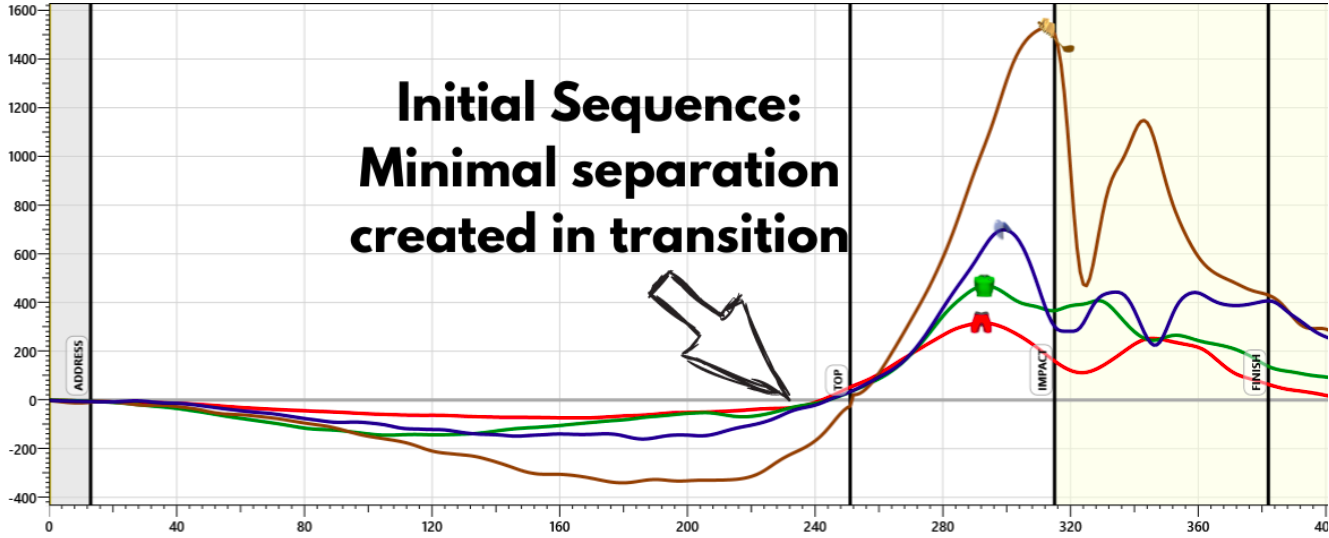
TPI Screen Results: Is there a Body-Swing Connection?
Once we have established the swing characteristics mentioned above we next want to determine if his body is contributing to this. Below you will see this golfer's TPI physical screen results on the left. In the middle picture you will notice this golfer's swing characteristics we mentioned above. On the right you will see his predicted swing characteristics just based on his screen results. In this case it is interesting to see how well the predicted characteristics matched up to his actual swing. Below we identify a few of the specific screens and how they relate to his swing.
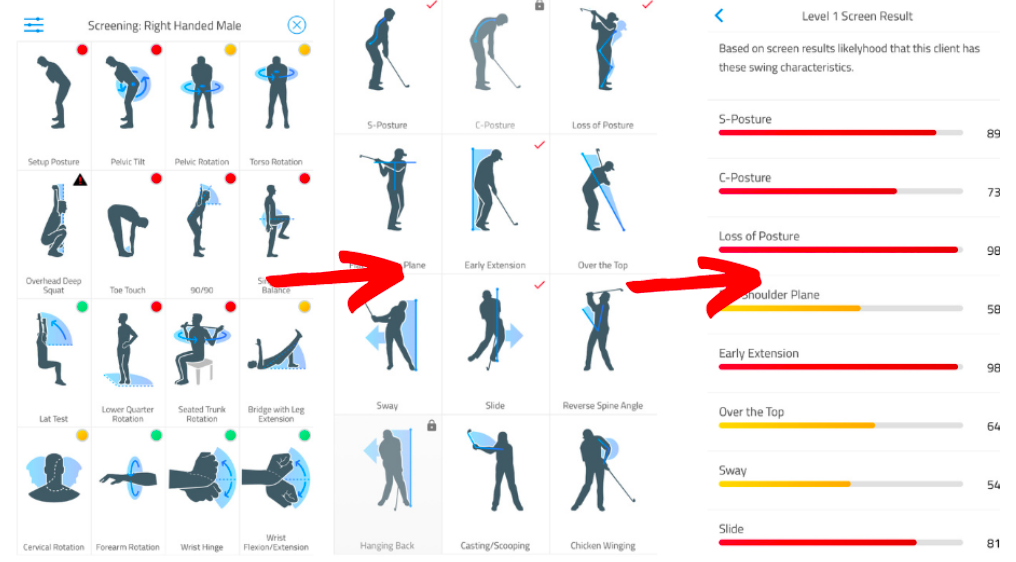
Pelvic Tilt Test:
This test has several implications for the golf swing. The ability to move and control the position of the pelvis is critical for optimal power transfer from the lower body to the upper body during the golf swing. It can also have implications for setup posture and maintaining posture during the swing.
In this case when he performed the test he had minimal movement tilting each direction. The client assumed that it was due to arthritis in his back. However, when we broke this down further and asked him to perform a similar movement on his back or hands and knees he was able to perform the movement without issue. Since he could now perform the movement this indicated an issue with stability or coordination of movement versus a mobility issue.
Seated Trunk Rotation Test
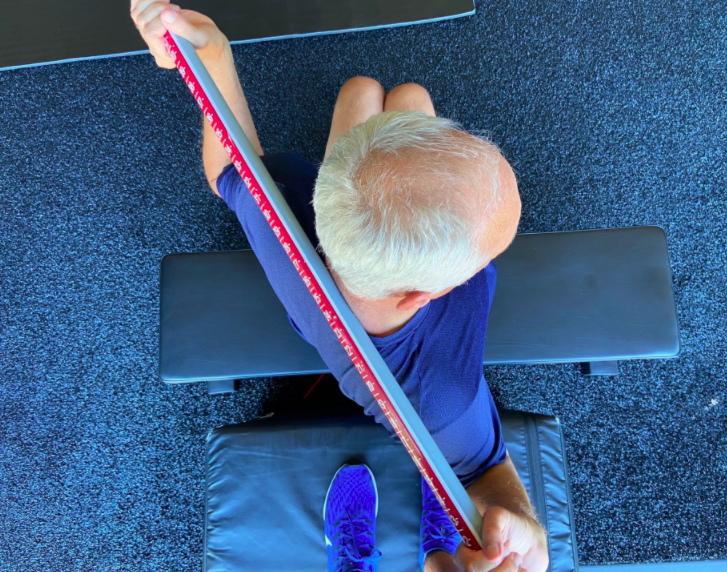
Torso Rotation Test:
The Torso Rotation Test checks the player’s ability to rotate the upper body independently from the lower body. To perform the test get in five-iron posture, with your arms crossed over their shoulders. Once in position, do not move the lower body while trying to rotate the upper body (the torso) back and forth This is an important skill for properly sequencing the backswing and generating a good separation or coil. This movement requires good mobility of the thoracic spine, and stability of the lower body.
In this case he had a very difficult time performing this movement and demonstrated a tendency to extend his spine instead of rotate during the movement. We knew that he had good mobility based on the test above and had more of an issue with stabilizing/controlling rotation. We identified this a likely significant connection to his loss of posture and reverse spine angle characteristic as well as limiting his overall shoulder turn and speed as well.
Pelvic Rotation Test:
The pelvic rotation test is a very important test for proper sequencing in the swing and optimizing speed and power in the swing. In this case he had a very difficult time creating any separation. This would line up well with what we observed in his swing in transition on the K Vest. In this test we stabilized his shoulders, he could now freely rotate the lower half and felt significantly easier. This is indicating more of an issue with stability in his torso than any limitation in mobility in his spine or hips.
Connecting the Dots: Based on the initial findings we determined the following
- There was a strong connection between his physical limitations and his swing characteristics that he was wanting to address.
- Talking with the golf professional we decided to focus on initially addressing the reverse spine angle and loss of posture.
- We agreed that prior to prioritizing the goal of additional speed, we would first try to clear up the trail side lower back pain. We identified several physical explanations for this as well as swing characteristics such as reverse spine angle and early extension that could be contributing to this.
- Assess Don't Assume: during the screening process the client was assuming that he initially needed more mobility and to stretch more and for most aging male golfers this is often the case. However, during his evaluation it quickly became obvious that he was above average flexibility in several areas and that he needed more stability and control of motion.
- In regards to speed and power generation in the swing we saw a couple potential areas to increase speed
- An improved ability to create more turn in his backswing would allow him greater time to apply force in the downswing and produce more speed.
- Very little pre stretch created on the muscles to initiate the downswing as mentioned above. A pre stretch on the muscles can create a rubber band like effect on the muscles that should result in more potential speed creation
- This golfer was also deficient in strength in the upper and lower body compared to the norms. Increased strength would allow him to apply more force to the club and likely more speed. A good base of strength would also help make sure he had a good foundation to add some of the speed work later in the program.
- We also noted significant imbalance in strength on the non dominant side. Dr. Greg Rose and Dr. Tom House have proposed the Big Break Theory that "you can only accelerate to the point of which your body knows you can safely decelerate. Therefore, the stronger and faster your decelerators are, the faster you can develop your accelerators". Addressing this asymmetry in strength on the left side would be related to this concept.
Step 2: Create the Program
Once we had the baseline information we then created a program centered around the priorities mentioned above. To keep this post from getting too long I will not share the entire program, but will highlight some of the key aspects of it.
Torso Rotation Correction
Pelvic Rotation Correction
Step 3 Reassess: 1 month follow up
K Vest and video swing analysis
At 1 month we reassessed his swing on K Vest. A couple of areas of progress were evident
- Significant improvement in maintaining posture and no longer has any reverse spine angle and is no compensating with his lower back to make his backswing.
- He has nearly 20 degrees more of rotation in the backswing (60 degrees initially compared to 80 degrees 1 month later).
- He also is better able to separate his upper body from his lower body with 20 more degrees of hip to shoulder separation. During the initial assessment he had 20 degrees and at the 1 month mark had increased this to 41 degrees.
- Better separation and downswing loading in transition to initiate the swing. This can be seen in the kinematic sequence graph below by the spacing between graphs in transition (where the arrow is pointing)
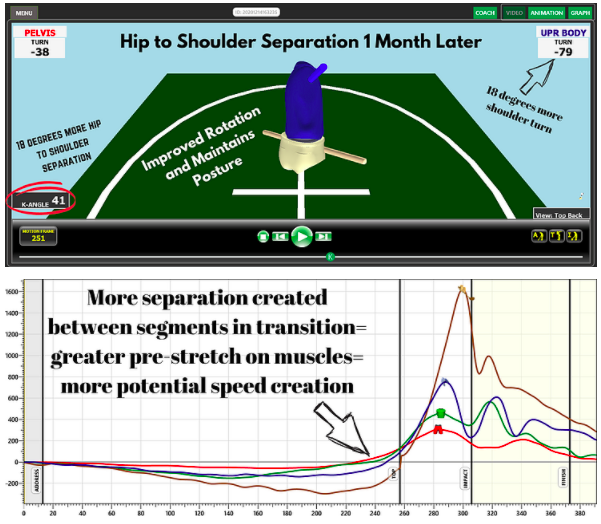
You can see a side by side difference of the initial swing and 1 month follow up below:
TPI Screen Results
It's important to reassess to make sure that you are making progress toward the targeted areas you are working on. In this case we did see that our hypothesis on the connections between his body and swing were correct.
Compared to the initial screen results we can see that he has better setup posture as well as improved core control and disassociation as shown in the pelvic tilt, pelvic rotation and torso rotation tests.
As he improved his body in some of the specific screens we saw he excellent carry over to his swing. At this point the lower back pain with golf was also no longer present.
As you can see there are still some yellow and red dots on the screen. The purpose of the screen is not to get a perfect score. Rather we want to understand the relationship between your body and your swing.
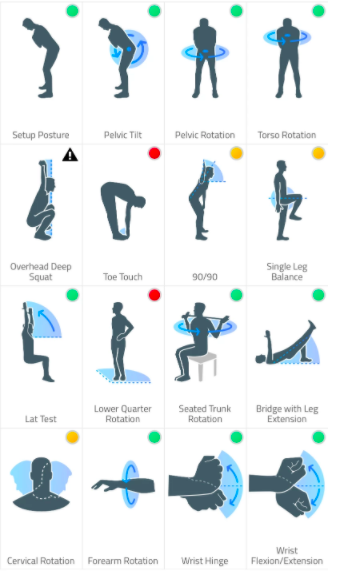
With this information you can either choose to address the limitation or coach around it. In this case the client wanted to improve the physical limitations. It's also important to note that each of the screen results is a pass/fail. Even though some of the tests were still a fail, this does not mean progress was not made. For example with single leg balance the client initially could only stand on one leg with eyes open for 2-3 seconds. He could now easily do this for 30+ seconds, but was still challenged with eyes closed.
What's the next step?
At this point he had eliminated the lower back pain and gained some club head speed (3 mph), but we still felt there was still room in the tank to add more speed and some other areas of 'low hanging fruit' that had not been addressed. We decided to advance into a strength program 3 times a week to address some of the deficits from the initial evaluation, while continuing to work on a few of the aspects of the TPI screen. We focused on this for another 8-10 weeks and again had another jump in club head speed. At this point we had decided to add SuperSpeed golf training into his program. He had asked about this at the initial evaluation and was eager to start the program, but did not feel like it was appropriate at the time due to the lower back pain as well as not having a good physical foundation to support this training. Once we added this in, he experienced another jump in club head speed and hit a peak speed with the driver of 107 (maxing out), but is now comfortably over 100 mph with the driver. I'm looking forward to his continued gains this offseason! I hope this post helps potential clients better understand some of our systems, how we approach golf fitness and how we can help you accomplish your golfing goals this upcoming season.

Jared Bickle graduated from the University of Indianapolis. He is a licensed physical therapist, Certified Orthopedic Manual Therapist, Functional Dry Needling Certified and a TPI Level 3 Medical and Fitness Professional. Jared is the owner of JB Performance and Reconditioning in Fort Wayne, Indiana which offers specialized rehabilitation services and performance training programs for golfers. He also offers K Vest 3-D motion capture services. He offers a variety of 1-on1 and small group programs as well as online/virtual programming. You can contact him by email at jared@jaredbicklept.com or find him on social media on Instagram or Facebook @jaredbickledpt